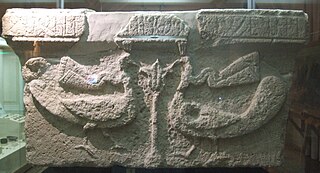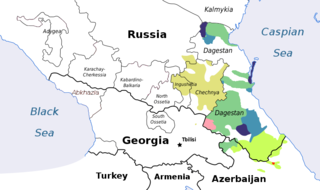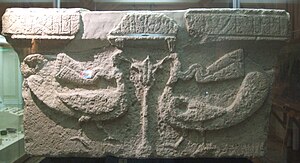
The Georgian scripts are the three writing systems used to write the Georgian language: Asomtavruli, Nuskhuri and Mkhedruli. Although the systems differ in appearance, all three are unicase, their letters share the same names and alphabetical order, and are written horizontally from left to right. Of the three scripts, Mkhedruli, once the civilian royal script of the Kingdom of Georgia and mostly used for the royal charters, is now the standard script for modern Georgian and its related Kartvelian languages, whereas Asomtavruli and Nuskhuri are used only by the Georgian Orthodox Church, in ceremonial religious texts and iconography.

The Caucasian languages are a large and extremely varied array of languages spoken by more than ten million people in and around the Caucasus Mountains, which lie between the Black Sea and the Caspian Sea.

Arran, also known as Aran, Ardhan, Al-Ran, Aghvank and Alvank, or Caucasian Albania, was a geographical name used in ancient and medieval times to signify the territory which lies within the triangle of land, lowland in the east and mountainous in the west, formed by the junction of Kura and Aras rivers, including the highland and lowland Karabakh, Mil plain and parts of the Mughan plain, and in the pre-Islamic times, corresponded roughly to the territory of modern-day Republic of Azerbaijan. The term is the Middle Persian equivalent to the Greco-Roman Albania. It was known as Aghvania, Alvan-k in Armenian, and Al-ran in Arabic.
The Udi language, spoken by the Udi people, is a member of the Lezgic branch of the Northeast Caucasian language family. It is believed an earlier form of it was the main language of Caucasian Albania, which stretched from south Dagestan to current day Azerbaijan. The Old Udi language is also called the Caucasian Albanian language and possibly corresponds to the "Gargarian" language identified by medieval Armenian historians. Modern Udi is known simply as Udi.

Koryun was the earliest Armenian-language historian. Writing in the fifth century, his "Life of Mashtots" contains many details about the evangelization of Armenia and the invention of the Armenian alphabet. Some Armenian and European scholars, such as G. Alishan, O. Torosyan, G. Fintigliyan, A. Sarukhan, G. Ter-Mkrtchyan (Miaban), S. Weber and others, have speculated that Koryun could have been an ethnic Georgian (Iberian) or Georgian-Armenian. Having received his early education under Mesrob Mashtots, Koryun went to Byzantium for higher studies, returning to Armenia with other students in 432. He was a close friend of Eznik Koghbatsi and Ghevond. Later, he was appointed Bishop of Georgia. He has been listed among the junior translators. His style is original, but somewhat obscure due to grammatical irregularities. To him have been attributed the translations of the three apocryphal books of the Maccabees. Koryun was the origin of the claim that the Georgian alphabet was created by Mesrob Mashtots.
The Udis are a native people of the Caucasus. Currently, they live in Azerbaijan, Russia, Georgia, Armenia, Kazakhstan, Ukraine and many other countries. The total number is about 10,000 people. They speak the Udi language. Some also speak Azerbaijani, Russian, Georgian and Armenian languages depending on where they reside. Their religion is Christianity.
Azerbaijan International is a magazine that discusses issues related to Azerbaijanis around the world. It was established in 1993 shortly after the dissolution of the Soviet Union when Azerbaijan gained its independence. Since then, it has been published quarterly in English with occasional articles in the Azerbaijani language in Latin and Arabic scripts. The magazine has offices in Los Angeles and Baku.

The Church of Kish, also known by different sources as Church of Saint Elishe or Holy Mother of God Church, is an inactive 12th or 13th century Caucasian Albanian church located in the village of Kiş approximately 5 km north of Shaki, Azerbaijan. It has functioned at different times as a Caucasian Albanian Apostolic church a Chalcedonian church within the Georgian Orthodox Church and later as Armenian Apostolic Church.
The Ethnic groups in Armenia is about the ethnic groups features of the population of Armenia.

The town of Nij, located forty kilometers south west of Qabala in Azerbaijan, is the world's only settlement of Udi people. It has a population of 5,744.

Nəsirvaz formerly Mesropavan is a village in the Ordubad Rayon of Nakhchivan, Azerbaijan. In the municipality of Bist village, it is located near the Ordubad-Nurgut highway, to the north-west of the district center, on the foothill. It has a population of 157.
The Armenian alphabet is an alphabetic writing system used to write Armenian. It was developed around 405 AD by Mesrop Mashtots, an Armenian linguist and ecclesiastical leader. The system originally had 36 letters; eventually, three more were adopted.

The Khinalugs are an indigenous people of Azerbaijan and speak the Khinalug language, a Northeast Caucasian language. The Khinalugs are indigenous to the Quba District and have been named after their main village, Khinalug. It is one of the peoples that have traditionally been called Shahdagh. Azerbaijani language is also widely spoken.

Caucasian Albanian is an extinct member of the Northeast Caucasian languages. It was spoken in Caucasian Albania, which stretched from current day south Dagestan to Azerbaijan. Linguists believe it is an early linguistic predecessor to the endangered North Caucasian Udi language. The distinct Caucasian Albanian alphabet used 52 letters.

This article discusses the Roman influence in Caucasian Albania.

Jost Gippert is a German linguist, Caucasiologist, author, and professor for Comparative Linguistics at the Institute of Empirical Linguistics at the Goethe University of Frankfurt.




















